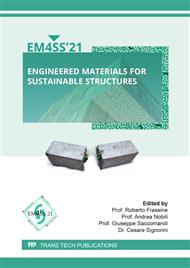[1]
Nanni, A. FRCM strengthening - A new tool in the concrete and masonry repair toolbox. Concr Int (2012) 34:43-49.
Google Scholar
[2]
CNR-DT 215/2018 (Italian commission of study for the predisposition and the analysis of technical norms related to the constructions): Instructions for the design, the execution and the control of static consolidation interventions through the use of fibre reinforced composites with inorganic matrix (2018).
Google Scholar
[3]
ACI 549.6R-20: Guide to design and construction of externally bonded Fabric-Reinforced Cementitious Matrix (FRCM) and Steel-Reinforced Grout (SRG) systems for repair and strengthening masonry structures. Farmington Hills, MI, USA (2020).
DOI: 10.14359/51702356
Google Scholar
[4]
de Felice G, D'Antino A, De Santis S, Meriggi P, Roscini F. Lessons learned on the tensile and bond behaviour of Fabric Reinforced Cementitious Matrix (FRCM) composites, Front Built Environ, section Earthquake Engineering (2020) 6:5.
DOI: 10.3389/fbuil.2020.00005
Google Scholar
[5]
EOTA (European Organisation for Technical Assessment). Externally-bonded composite systems with inorganic matrix for strengthening of concrete and masonry structures. European Assessment Document (EAD) 340275-00-0104 (2018).
Google Scholar
[6]
CSLLPP (Italian High Council of Public Works). Guidelines for the identification, the qualification and the acceptance of fibre-reinforced inorganic matrix composites (FRCM) for the structural consolidation of existing constructions (2018).
Google Scholar
[7]
CSLLPP (Italian High Council of Public Works). Guideline for the identification, the qualification and the acceptance of preformed mesh systems made of fiber-reinforced polymer matrix composite materials to be used for the structural consolidation of existing buildings using the CRM (Composite Reinforced Mortar) technique (2019).
Google Scholar
[8]
Huang X, Birman V, Nanni A, Tunis G. Properties and potential for application of steel reinforced polymer and steel reinforced grout composites. Compos Part B-Eng (2005) 36:73-82.
DOI: 10.1016/s1359-8368(03)00080-5
Google Scholar
[9]
Borri A, Casadei P, Castori G, Hammond J. Strengthening of brick masonry arches with externally bonded steel reinforced composites. J Compos Constr (2009) 13(6):468-475.
DOI: 10.1061/(asce)cc.1943-5614.0000030
Google Scholar
[10]
Valluzzi, M.R., Da Porto, F., Garbin, E., Panizza, M. Out-of-plane behavior of infill masonry panels strengthened with composite materials. Mat Struct (2014) 47(12): 2131-2145.
DOI: 10.1617/s11527-014-0384-6
Google Scholar
[11]
Thermou, G.E. Katakalos, K., Manos, G. Concrete confinement with steel-reinforced grout jackets. Mat Struct (2015) 48(5): 1355-1376.
DOI: 10.1617/s11527-013-0239-6
Google Scholar
[12]
De Santis, S., Roscini, F., and de Felice, G. Full-scale tests on masonry vaults strengthened with Steel Reinforced Grout. Compos Part B-Eng (2018) 141: 20-36.
DOI: 10.1016/j.compositesb.2017.12.023
Google Scholar
[13]
De Santis S, De Canio G, de Felice G, Meriggi P, Roselli I. Out‑of‑plane seismic retrofitting of masonry walls with Textile Reinforced Mortar composites, Bull Earthquake Eng (2019) 17:6265-6300.
DOI: 10.1007/s10518-019-00701-5
Google Scholar
[14]
Ascione, F., Lamberti, M., Napoli, A., Realfonzo, R. Experimental bond behavior of Steel Reinforced Grout systems for strengthening concrete elements. Constr Build Mater (2020) 232: 117105.
DOI: 10.1016/j.conbuildmat.2019.117105
Google Scholar
[15]
Plizzari G, Giuriani E, Poverello E, Algeri C. Experimental study on the injected anchors behaviour on historical masonry, Adv Mater Res (2010).
DOI: 10.4028/www.scientific.net/amr.133-134.423
Google Scholar
[16]
Girardello P, Panizza M, Garbin E, Valluzzi M. R, Cardani G, Dalla Benedetta M, Casadei P. On-site pull-out tests of steel anchor spikes applied to brickwork masonry, Key Eng Mat (2015) 624: 266-274.
DOI: 10.4028/www.scientific.net/kem.624.266
Google Scholar
[17]
Razavizadeh, A., Ghiassi, B., Oliveira, D.V. Bond behavior of SRG-strengthened masonry units: Testing and numerical modeling. Constr Build Mater (2014) 64:387-397.
DOI: 10.1016/j.conbuildmat.2014.04.070
Google Scholar
[18]
De Santis S., Ceroni F., de Felice G., Fagone M., Ghiassi B., Kwiecień A., Lignola G.P., Morganti M., Santandrea M., Valluzzi M.R., Viskovic A. Round Robin Test on tensile and bond behaviour of Steel Reinforced Grout systems. Compos Part B-Eng (2017) 127:100-120.
DOI: 10.1016/j.compositesb.2017.03.052
Google Scholar
[19]
De Santis S. Bond behaviour of Steel Reinforced Grout for the extrados strengthening of masonry vaults. Constr Build Mater (2017) 150:367-382.
DOI: 10.1016/j.conbuildmat.2017.06.010
Google Scholar
[20]
De Santis S, Hadad HA, De Caso y Basalo FJ, de Felice G, Nanni A. Acceptance Criteria for Tensile Characterization of Fabric Reinforced Cementitious Matrix (FRCM) Systems for Concrete and Masonry Repair, J Compos Constr (2018) 22:04018048.
DOI: 10.1061/(asce)cc.1943-5614.0000886
Google Scholar
[21]
ASTM International. Standard specification for chromium and chromium nickel stainless steel plate, sheet, and strip for pressure vessels and for general applications. ASTM A240/A240M-16a. West Conshohocken, PA: ASTM International (2016).
DOI: 10.1520/a0240_a0240m-13c
Google Scholar
[22]
Fares S, Fugger R, De Santis S, de Felice G. Strength, bond and durability of stainless steel reinforced grout, Compos Part B-Eng. Submitted for publication.
DOI: 10.1016/j.conbuildmat.2022.126465
Google Scholar


